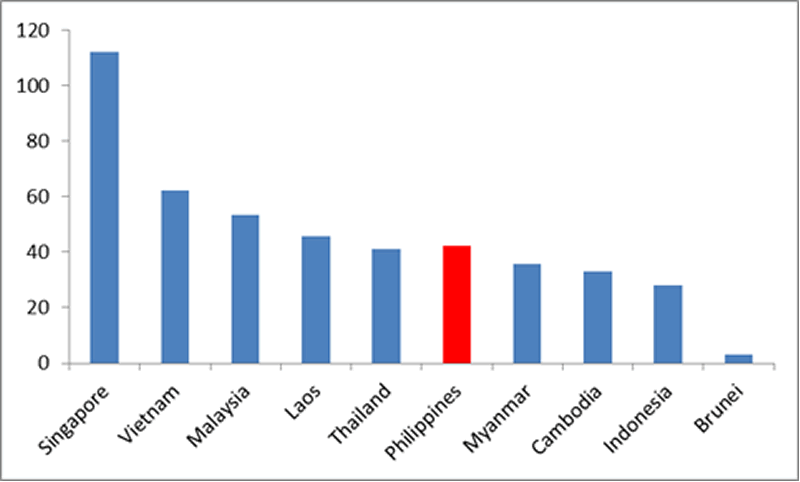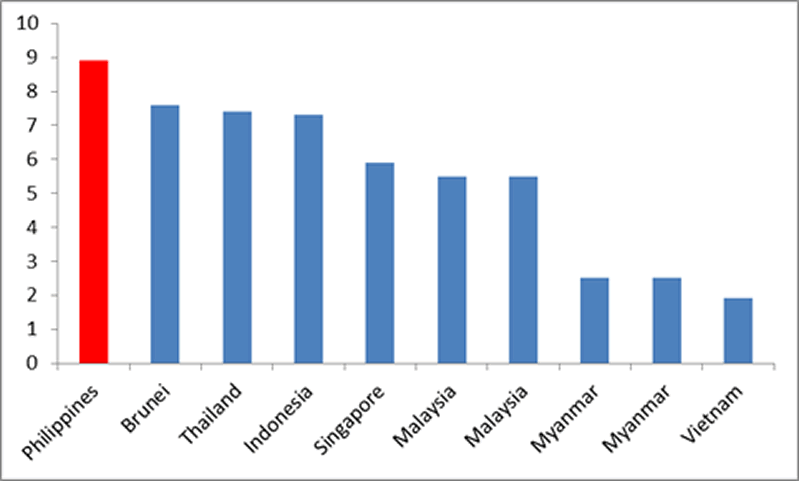The Myths and Realities of Duterte’s Infrastructure Initiative
Politics / Asian Economies Aug 01, 2017 - 07:43 AM GMTBy: Dan_Steinbock

 A huge upgrade of infrastructure is vital for Philippines economic future. That’s why it is contested by entrenched interests, including foreign powers. This is the first in a series of occasional commentaries about the Philippines transformation from an international viewpoint.
A huge upgrade of infrastructure is vital for Philippines economic future. That’s why it is contested by entrenched interests, including foreign powers. This is the first in a series of occasional commentaries about the Philippines transformation from an international viewpoint.
In the past year, President Duterte has initiated a series of economic reforms to accelerate economic development. Despite much “political noise,” the government seeks sustained growth around 6.5- 7% in 2017, by banking on multiple initiatives, especially higher infrastructure spending.
According to Ernesto Pernia, Director General of the National Economic and Development Authority (NEDA), investment spending must be ramped up to 30% of GDP for Philippines to become an upper middle-income economy by the end of Duterte’s term in 2022, and to pave the way for a high-income economy by 2040.
Yet, the huge infrastructure investment effort has been often misreported internationally. Infrastructure investment is a case in point.
The allegation: Infrastructure as “debt slavery”
In early May, Secretary of Budget and Management Benjamin Diokno estimated that some $167 billion would be spent on infrastructure during President Duterte’s six-year term. Only a day later, U.S. business magazine Forbes released a commentary, which headlined that this debt “could balloon to $452 billion: China will benefit.”
According to the author, Dr. Anders Corr, the current Philippine government debt of $123 billion is about to soar to $290 billion because China, the “most likely lender,” would impose high interest rates on the debt: “Over 10 years, that could balloon Philippines’ debt-to-GDP ratio as high as 296%, the highest in the world.”
These figures assume absence of transparency by the Duterte government and China on the interest rate, conditionality and repayment terms of $167 billion of new debt for the Philippines. Due to accrued interest, “Dutertenomics, fueled by expensive loans from China, will put the Philippines into virtual debt bondage if allowed to proceed.” He assumes China’s interest rate would amount to 10%-15%.
But why would the Philippines accept such a nightmare scenario? Because, as Corr puts it, “Duterte and his influential friends and business associates could each benefit with hundreds of millions of dollars in finders fees, of 27%, for such deals.”
He offers no facts or evidence to substantiate the assertions, however.
The official story: Debt decline, despite infrastructure investment
Recently, the Department of Budget and Management (DBM) anticipated the Philippine debt position to remain sustainable, despite deficit spending for infrastructure. Between 2017 and 2022, the Duterte government plans to spend about $160 billion to $180 billion to fund the “Golden Age of Infrastructure.” An expansionary fiscal policy shall increase the planned deficit to 2-3% of GDP.
To finance the deficit, the government will borrow money following an 80-20 borrowing mix in favor of domestic sources, to alleviate foreign exchange risks – which would seem to undermine the story of China as the Big Bad Wolf.
The fiscal strategy is manageable because the economy, despite increasing deficit, will outgrow its debt burden as economic expansion outpaces the growth in the rate of borrowing. So what is the expected impact on the debt-to-GDP ratio?
Given deficit spending of 3% of GDP, the DBM assumes growth will be 6.5%-7.5% this year and 7%-8% from 2018 to 2022 (plus inflation of 2%-4%). As a result, it projects the debt-to GDP ratio to decline from 41% in 2016 to 38% in 2022.
The realities: Growth over deficit financing
The current Philippine debt-to-GDP ratio compares well with its regional peers. It is half of that of Singapore and less than that of Vietnam, Malaysia, Laos and Thailand (Figure 1). The starting point for a huge infrastructure upgrade is favorable. True, in a downscale risk analysis, Philippine growth performance might not reach the target, but would be likely to stay close to it – which would still translate to a manageable increase in the debt-to-GDP ratio.
Figure 1 ASEAN: Debt-to-GDP Ratio, 2016 (%)

Yet, Corr claims that Philippine debt ratio will soar seven-fold in the Duterte era, whereas the DBM estimate offers evidence the debt could slightly decline. The difference between the two is almost 260%.
Today, Japan’s debt-to-GDP ratio exceeds 250% of its GDP. However, at the turn of the 1980s, the ratio was still closer to 40%, or where the Philippine level is today. Yet, Corr claims Duterte government would need barely 4 years to achieve not only Japan’s debt ratio today but a level that would be another 50% higher!
The realities are very different, however. The contemporary Philippines enjoys sound macroeconomic fundamentals, not Marcos-era vulnerability. Moreover, Corr’s tacit association of Duterte’s infrastructure goals with former President Marcos’s public investment program (and the associated debt crisis in the 1980s) proves hollow. Duterte is focused on infrastructure (his infrastructure budget as percentage of GDP is 2-3 times higher in relative terms).
Today, borrowing conditions are also more favorable (365-day Treasury bill rates are 3-4 times lower than in the Marcos era). Furthermore, the Philippine gross international reserves, which amount to 9 months, are relatively highest among ASEAN economies and 3-4 times higher than in the Marcos era (Figure 2).
Figure 2 Gross International Reserves, 2015-16 (months)

In addition to realities, Corr’s analysis ignores the dynamics of debt. Any country’s debt position is not just the nominal amount of the debt, but its value relative to the size of the economy. An economy that is barely growing and suffers from dollar-denominated debt lacks capacity to pay off its liabilities, as evidenced by Greece. In contrast, with its strong growth record, the Philippines has the capacity to grow while paying off its liabilities.
Geopolitical agendas, economic needs
Corr could have challenged DBM’s assumptions about Philippines future growth, potential increases in infrastructure budget, contingent adverse shifts in the international environment and so on, but his purposes may be political.
He is close to US Pentagon and intelligence communities, which strongly oppose Duterte’s recalibration of Philippines foreign policy between the US and China. According to US Naval Institute, he has visited all South China Sea claimant countries and undertaken “field research” in Vietnam, the Philippines, Taiwan, and Brunei. He has been an associate for Booz Allen Hamilton (as once was Edward Snowden). Though he has ties with international multilateral banks, he is less of an “economic hit man” and has more interest in U.S. security matters.
Corr led the US Army social science research already in Afghanistan and conducted analysis at US Pacific Command (USPACOM) and U.S. Special Operations Command Pacific (SOCPAC) for U.S. national security in Asia, including in the Philippines, Nepal, and Bangladesh. Currently, he is researching Russia and Ukraine for the Pentagon. He has urged President Trump to use stronger military presence in the South China Sea, bullied Pakistan with sanctions, and supported independentistas in Hong Kong and Taiwan, labeled Chinese students abroad as Beijing’s informants, while exploring US nuclear options against North Korea.
Such objectives are far from neutral economic observation, but they do reflect political partisanship that is typical to Washington’s neoconservative and liberal imperial dreams– but not the views of most Americans, according to major polls.
In the Philippines, Duterte’s supporters see Chinese debt as a business deal that will ultimately support the country’s future. After Forbes, the Duterte government’s critics were quick to report the story, but without appropriate examination of its economic assertions and possible strategic motives. Overall, while liberals tend to oppose the debt plans for geopolitical reasons, their economists are more sympathetic.
In any real assessment, simple realism should prevail: When the rate of economic expansion exceeds that of debt growth, low-cost financing for public projects can make a vital contribution to the Philippines’ economic long-term future.
Dr. Dan Steinbock is an internationally recognised expert of the nascent multipolar world. He is the CEO of Difference Group and has served as Research Director at the India, China and America Institute (USA) and visiting fellow at the Shanghai Institutes for International Studies (China) and the EU Centre (Singapore). For more, see www.differencegroup.net
© 2017 Copyright Dan Steinbock - All Rights Reserved
Disclaimer: The above is a matter of opinion provided for general information purposes only and is not intended as investment advice. Information and analysis above are derived from sources and utilising methods believed to be reliable, but we cannot accept responsibility for any losses you may incur as a result of this analysis. Individuals should consult with their personal financial advisors.
© 2005-2022 http://www.MarketOracle.co.uk - The Market Oracle is a FREE Daily Financial Markets Analysis & Forecasting online publication.


